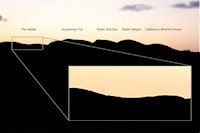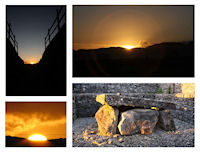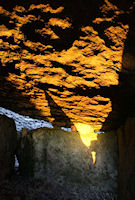
Figure 8: The saddle, with the Ballygawley Mountains to the right
A number of features of the Listoghil chamber serve to establish its directionality, in particular the chamber plan, an irregular hexagon bounded by the backstone E and the gable stone B opposite it. Between these two, a pair of inward-angled 'portals' (C and G) stand on either side of B. Between the portals and the backstone, on either side, are two lower, longer orthostats (D and F). These side orthostats bear a number of points of resemblance to each other. Thus an axis of symmetry is discernible, running west-northwest/east-southeast through the long axis of the chamber. Even the burnt patches in Burenhult's plan (Figure 3) seem to respect this axis. Although the roof-slab is asymmetrical in shape, it is tilted towards ESE along the axis of the chamber. The idea of axes running through passage tombs is not novel, it has been remarked on by Robin (2010, 397), McMann (1991) and others. The kerbstone circle itself also has a slight tendency to favour the direction of the chamber in that the bigger and more patterned kerb stones are placed towards the east-southeast.
Around 2006, Mark Keane, then the Sligo County Council field monuments advisor, noted that the chamber pointed to a saddle-like depression (Figure 8) to the left of Aughamore Far in the Ballygawley Mountains. The saddle was a natural feature, defined by two spurs on either side, which, it appeared, would very neatly contain the disk of the sun. Mark suggested that the saddle lay in the direction of the Samhain/Imbolc sunrise. This part of the horizon profile has an almost symmetrical form. On either side of the spurs, a pair of raised hillocks sweep outwards like splayed wings.
Bergh estimated the direction of the chamber at 123.3° (137° on the 400° dial: measurements magnetic) (1995, 125). The chamber direction was established by the method outlined by Bergh i.e. taking a line from the midpoint of the backstone [E], internally, through the centre point between the 'front' orthostats C and G. The resulting line ran precisely through the centre of the saddle. The compass bearing was 116.4° from north (121.4° magnetic).
31 October 2008 was a beautiful crisp morning, one of the year's first frosts. In the moments before sunrise the Ballygawley Mountains appeared to burn, and fingers of sunlight threaded the sky. The four peaks of the Ballygawley Mountains huddled on the horizon, the passage tombs at each of their summits clearly discernible; Aughamore Far to the north, Sliabh Dhá Éan, Sliabh Dargan and Cailleach a Bhérra (Figure 8). As the light intensified before sunrise the sense of expectation increased. Suddenly, a brilliant sliver of sun-disk appeared, close and immediate. The land darkened under the fire. On October 31, the sun rose just off-centre left in the saddle and shone directly down the 'passage' of Listoghil, and through the chamber. Queen Meadbh's cairn on Knocknarea was illuminated by sunlight approximately one minute before the sun reached the central tomb in Carrowmore.
The slight taper of the chamber (in plan) towards the east-southeast has the effect that every stone is touched by the rising sun at Samhain/Imbolc. Like a box bursting with deep orange light, it appears almost transparent when illuminated by direct sunlight (Figure 9).

Figure 9: Images of sunrise at Listoghil, 31 October 2008. (Photo [bottom left] Jean Ryan: reproduced with permission). Top right: sunrise, 11 February 2009
The roof-slab of the chamber is rough and undulating on its underside. At the instant of sunrise, all the features of this surface stood out in high-contrast relief. The roof-slab tilt of Listoghil means the underside catches the first rays of the sun. The shadow of the blocking stone, stone B, forms a long (c.1m) thin spear-like shape along the belly of the roof-slab, like the single finger of a sundial (Figure 10). At this point, most of the backstone (E) is shadowed by stone B but stone B does not block all the light. A yellow/orange 'V' of sunshine, bounded by shadow, appears on the right side of the backstone. As the sun rises, the 'spear' retracts along the roofstone belly, while the light 'V' drops across the backstone to the right. After approximately ten minutes, the shadow of stone B and the V of light disappears in the shadow of the reconstructed passage.

Figure 10: The 'spear of darkness' on the under side of the roof-slab of Listoghil, 10 February 2010.
I visited again on the following day, November 1. The sun rose directly in line with the chamber of Listoghil, at 7:45am on October 31 and slightly to the right of it, about three minutes later, on 1 November 2008. The sun rose and travelled at a shallow angle from behind the hills and climbed over the Ballygawley Mountains. By November 5, sunrise was no longer visible from the chamber; the restored cairn obstructed the view. The next time the sun shone into the chamber at right angles to the backstone was 11 February 2009. (10 February 2009 was cloudy. A direct alignment was also seen on 10 February 2010.)
In 2008 I continued to observe intermittently the progress of sunrise through the winter from the front kerbstone of Listoghil. The journey south across the Ballygawley Mountains began as a sprint. But on reaching the last of the four hills, the runner seemed to dally, then to stall. The passage tomb on this hill is the house, according to local folklore, of the winter witch, An Cailleach Bhérra. Sunset reaches the north base of the hill on 26 November. It creeps up the hill; there is a moment of drama on 2 December when the sun-disk stands poised at the peak of Cailleach a Bhérra; then, on 11 December, it stops dead. Sunrise standstill occurs half-way down the south limb of Cailleach a Bhérra. It holds this position for almost three weeks. It rises from the peak again on 10 January. By 15 January it has returned to the north edge of Cailleach a Bhérra. And so for 50 of the 102 days between the 'events' of early November and early February (effectively half of the winter) the sun, viewed from Listoghil, rises from some part of Cailleach a Bhérra. The winter-end event occurs on the 10 and 11 February.
A local story describes the form of the rounded hillocks as the witch lying on her back (Michael Quirke, pers. comm.). There is no local folklore, however, that describes the journey of the sun along the body of the witch, travelling up her belly and breasts to rest at her head at midwinter.
© Internet Archaeology/Author(s)
University of York legal statements | Terms and Conditions
| File last updated: Wed Jul 18 2012